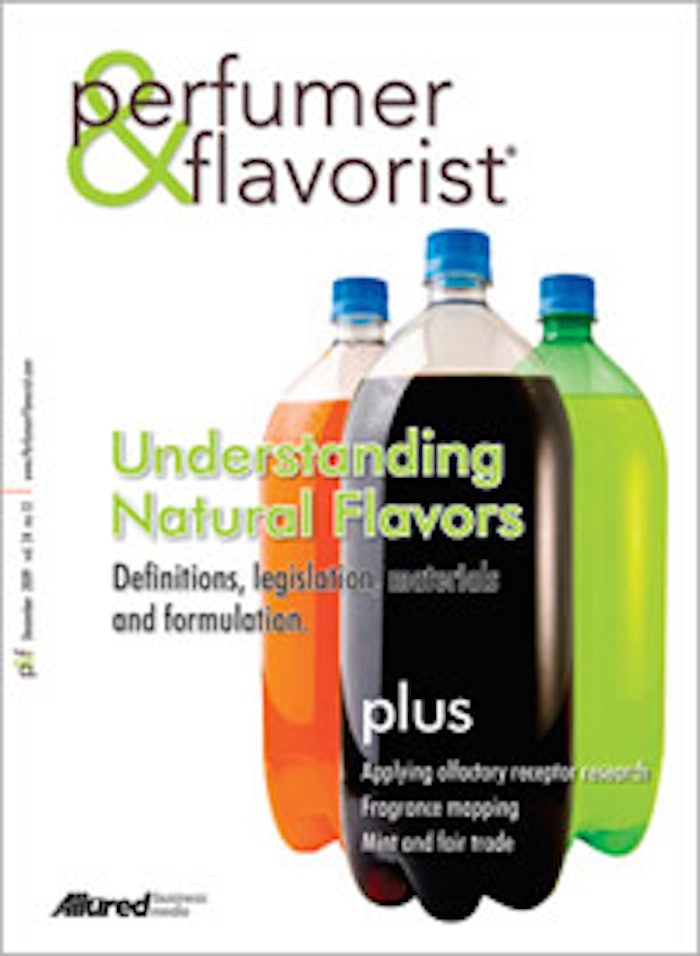
The December 2009 issue of Perfumer & Flavorist magazine focuses on understanding natural flavors—definitions, legislation, materials and formulation. In addition to news, analysis, new product introductions and events, highlights include:
Who Steers the Ship?
By: John Wright
We are all keenly aware of the strengths and vulnerabilities of our respective companies. Perhaps, many of us in our quieter moments have a mental image of the perfect Elysian flavor company. Thankfully, most of those images are radically different from each other; otherwise, we would be living in a very boring world. I have worked in every conceivable structure, and over the years my view of the perfect company has changed dramatically with different experiences. Due to space limitations, I will focus this article on only one aspect of my idea of a perfect company: Who steers the ship?
Molecule of the Month: Nootkatone
By: Michael Zviely, CIC
Nootkatone is a crystalline material possessing an extremely powerful grapefruit aroma and a woody topnote. It is found in citrus oils (for example, grapefruit) and can be purified from both citrus cold pressed oils and essential oils. Due to its powerful citrusy, woody, sweet juicy notes, and peely and grapefruitlike aroma profile, nootkatone is used in formulation of grapefruit and other citrus-flavored beverages. In fragrances, it is used in creation of dry and citrusy compounds for men’s perfumes.
Fragrance Perception: Is Everything Relative?
By: Laura Donna
There are many fragrance lovers—this author included—who focus on the essential truth of perfume, caring little that it “smells different” on everyone. Such fragrance lovers are annoyed by the cult of subjectivity suggesting that a scent may actually smell different to Jim than it does to Jane. For such people, a recent paper by Manuel Zarzo and David Stanton reveals good news: Everything is not relative. Perhaps a rose is a rose is a rose is a rose. Driven by a desire to better understand the relationships among odor descriptors most frequently used in perfumery, the scientists published a landmark study of fragrance perception. Their conclusions: A standard map of odor descriptors is possible; perfume materials can be presented nicely in two-dimensional space.
Naturally Does It
By: Steve Pringle (with John Gilroy), Frutarom USA
When I was growing up my grandfather used to tell me a particularly bad joke: “When is a door not a door? When it’s ajar.” I used to think this joke was pretty funny as I imagined our front door becoming a large jar, usually full of jelly, rather than contemplating the play on words the joke actually represented. Today, when I talk to friends about the F&F industry, I use a similar line: “When is a strawberry not a strawberry? When it’s a strawberry flavor.” After some simple explanation on how flavors are created, their normal reply to this is: “What? Even when it’s a natural flavor?” And here the can of worms opens. Just what is natural? How does legislation affect the flavorist and what he or she is trying to achieve? How can material suppliers help—or in fact hinder—this process?
Using the Brain (Not the Nose) to Smell
By: Stephen Dowthwaite, PerfumersWorld
Over the past 10 years I have had the pleasure of instructing more than 6,000 students via online courses and in-person workshops and private courses. Their ages have ranged from eight to 80, from complete beginners to some of the most experienced professionals in our industry. One of the first questions I ask in the workshops is, “Have you ever had lessons in how to smell?” I usually raise my hand in the hope of encouraging a positive response. Usually receiving none, I will dig further and add something like, “Maybe your mother sat with you and went through smells with you.” Still, without fail, I will receive no response. It seems incredible that the most important and fundamental of techniques to the perfumer’s and flavorist’s skill—smelling—is hardly, if ever, systematically taught, even for those in the industry.
Organoleptic Characteristics of Flavor Materials
By: Gerard Mosciano and Judith Michalski
Gerard Mosciano is joined by Judith Michalski, flavor consultant; Carl Holmgren, consulting flavor chemist; William Jaggard, Bell Flavors; and Douglas Young, principal flavorist, Symrise, in the organoleptic evaluations presented here. Organoleptic evaluations on 3-ethyl-2,6-dimethyl pyrazine, 2-iso propyl phenol, 3-hexanol, 3-methyl-2-butanethiol and more.
Progress in Essential Oils
By: Brian M. Lawrence
Compositional evaluations of lemon-scented tea tree oil, cypress oil and Mexican oregano oil.
Fair Trade Sourcing: Organic Mint
By: Daemmon Reeve, Earthoil Plantations Ltd., with an introduction from Jeb Gleason-Allured, Editor
According to a new Natural Marketing Institute report, when it comes to the triple bottom line concept—people, planet and profit—consumers have turned against the “‘whatever the cost’ strategy” of previous years in favor of the first two pillars. “[C]onsumers clearly want more focus on the social and environmental legs of the stool, while profit takes a back seat,” the report notes. “Whereby this result might be expected, it points out the need for responsible capitalism.” NMI adds that, far from being anti-profit, the financial opportunities are significant, estimating that the market for lifestyles of health and sustainability (commonly referred to as LOHAS) is about $209 billion and growing rapidly.










